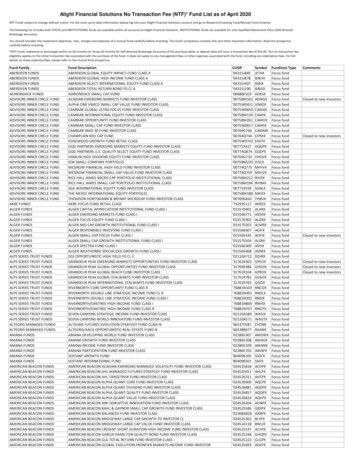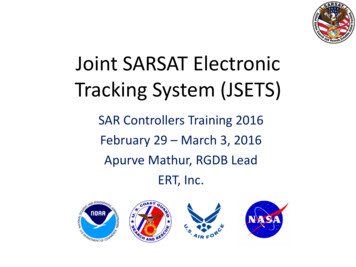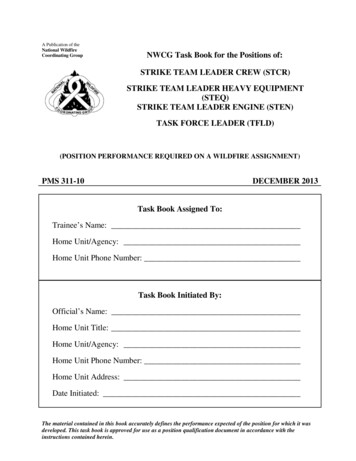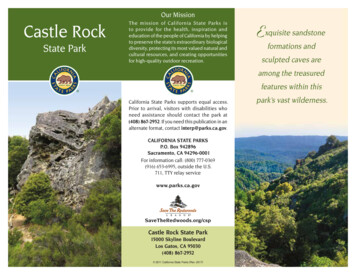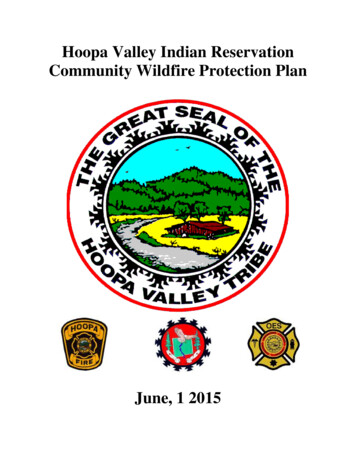Transcription
Beacon RockCommunity Wildfire Protection PlanPrepared by: Gail A. Fullerton, Skamania County Wildfire Prevention Coordinator andOle Helgerson, Washington State University Skamania County Extension DirectorPO Box 790, Stevenson, WA 98648
Beacon Rock Community Wildfire Protection Plan (CWPP)Table of ContentsI.INTRODUCTIONGoalsMissionCommunity ity Wildfire Protection Plan Requirements335III.COMMUNITY PROFILELocationClimateTopography and VegetationFire HistoryPopulationTransportationCritical Infrastructure44455667IV.PLANNING PROCESS (Partners and Steps Taken)Step One: Convene Decision Makers, Federal Agenciesand Interested Parties(HFRA Requirement 1)Step Two: Establish Planning AreaStep Three: Community OutreachStep Four: Community Wildfire Risk Assessment (Factors affecting the severity of wildfire)Risk assessment process Phase I1. Ignition risk2. Hazardsa. Weatherb. Topographyc. Fuels3. Values protected4. Emergency Equipment and Staffing InventoryRisk assessment process Phase II1. Map Workshop2. Gap Workshop3. Gaps Identified4. Data available for decision makingStep Five: Establish Community Priorities andRecommendations for Projects (HFRA Requirements 2 and 3)1. Table 1: Project Summary2. Project Descriptionsa. Fuel Reduction (HFRA requirement 2)b. Planningc. Education (HFRA requirement 3)d. Equipment, Staffing, and ExerciseStep Six: Develop an Action Plan and Assessment Strategy (HFRA Requirement 3)1. Assessment Strategy2. Action Plan3. Table 2: Action Plan Project 0202020i
Step Seven: Community Wildfire Protection Plan Approval and Compliance Standards4. Approval5. FEMA as & Meeting MinutesB.Community QuestionnaireC.NFPA-299 Hazard Rating FormD.Wildfire Protection CapabilitiesE.Current Inventory and Future NeedsF.―Living With Fire, A Guide for the Homeowner‖G.FEMA Pre-Disaster Mitigation ComplianceH.MapsH1 – Planning Area LocationH2 – Planning AreaH3 – Fire HistoryH4 – TopographyH5 – Communities At riskH6 – Anderson Fuel Model22Figure 1. (Appendix H1 Planning Area Location)Acknowledgements:This plan would not have been completed without the support of the Skamania County Commissioners, whoallocated the Title III School and Rural Community funds used to complete it. The Skamania County FD #5 andNorth Bonneville volunteer fire fighters, and their officers provided key insights and leadership during the CWPPprocess. Ole Helgerson (WSU Extension, retired) has been the prime mover of this ―Firewise‖ project since itsinception in 2002; Sara Zielin (Wildfire Prevention Coordinator 2007- 2008) created the planning/meeting processused for this CWPP and wrote three Skamania County CWPPs (Greater Wind River, Swift and West End). GregPage and Heather Stiles of the USDA Forest Service, and Russ Hovey of Washington Department of NaturalResources provided support and expertise essential to this CWPP. Don Chambers and Frances Heller collectedGPS and edited GIS used to complete this plan.ii
INTRODUCTION:A Community Wildfire Protection Plan (CWPP) allows a community in the Wildland Urban Interface (WUI) to take action toreduce its vulnerability to wildfire. Skamania County and Washington State University Skamania County Extensionfacilitate CWPPs through a Title III grant from the Secure Rural Schools and Community Self-Determination Act of 2000(PUBLIC LAW 106–393). This plan will serve as a standalone document and as a chapter to Skamania County, WAEmergency Management Plan, and provide a framework to emergency responders, property owners, and interestedparties within the planning area to increase the communities‘ capacity to be better prepared for a wildfire. The planidentifies communities at risk (CAR) and values that would be vulnerable during a wildfire.For the purpose of this project, the entire planning area is considered to be WUI.Residents of the Beacon Rock CWPP area are concerned about the effects of wildfire on their community. Although earlyfire suppression efforts in the CWPP area have been successful, several large fires have occurred nearby in recent yearsand numerous stand replacing fires have occurred in the last century in the CWPP area. Residents, government officials,and fire department personnel understand the potential for catastrophic wildfire in the area, and have joined together toproactively plan and implement actions to reduce the impact of wildfire on the community.MissionThe Beacon Rock CWPP mission is ―Protection of Life, Property, (both private and public), and Natural Resources fromfire through education, planning, and action.‖Through this CWPP, residents of the Beacon Rock CWPP area intend to protect their community from the effects ofwildfire through outreach, education, strategic planning, and action. They wish to face each fire season confident that theyhave done everything possible to prepare for and mitigate the effects of a potential forest fire in their area.GoalThe primary goal of the Beacon Rock CWPP is to protect life, property, essential infrastructure, and resources through theimplementation of fire prevention projects that work to increase public awareness, provide escape routes, provide shelter―in place‖, improve forest health, sustain local wildlife, and preserve the natural beauty of the area.To achieve this goal, the Beacon Rock Steering Committee developed specific projects which support the following threeobjectives:1. Improve the chance of survival for people, animals, homes, and the environment during wildfires2. Promote wildfire awareness and education for citizens located in ‗risk areas‘3. Engage in community-developed fuels treatment projects that reduce wildfire vulnerability of communities at risk.In an effort to minimize waste, all options for the utilization of biomass produced from fuels reduction projects will beevaluated.Community AwarenessResidents of the Beacon Rock CWPP area are very aware of the need to develop a comprehensive wildfire preventionand protection plan. The Beacon Rock CWPP area is located at the interface of the drier eastern Washington forests andthe wetter western forests. The drier forests experience frequent low intensity fire, while the wetter forests experienceinfrequent but catastrophic fires. (Figure 2) the potential for a fire from the east to spread into the west and becomecatastrophic is enormous. Years of fire suppression have led to large accumulations of woody fuels.SR 14 and railroad tracks run along the southern boundary of the planning area and are a source of frequent fire ignition.Steep slopes parallel the tracks and SR 14 to the north. The Columbia Gorge forms a wind tunnel providing high velocitywind to drive the fire. All the ingredients to create catastrophic fire are present here.Concerned residents began organizing in July of 2008. Their energy, input, and guidance have played an essential role inthe creation of this CWPP. In addition to regular planning meetings, they have created a Steering Committee anddeveloped an action plan. The Beacon Rock CWPP action plan includes education of planning area residents on theimportance of defensible space and a conviction to see defensible space created, establishing evacuation routes andassembly points, and placing signage providing information on fire danger. The Beacon Rock CWPP communities arecommitted to taking action on this plan.Beacon Rock CWPP1
IFI Fire intensity (how fast and hot a fire burns)F Fire frequency (how often fire occurs)Forests of Douglas-fir with western hemlock and western red-cedarForests of ponderosa pine and Oregon oakBunchgrass steppe of bluebunch wheatgrassForests of Silver fir, noble fir, western white pine, western hemlock and Alaskayellow cedarForests of grand fir, western white pine, lodgepole pine, ponderosa pine,western larch and Douglas-firSub-alpine forest of mountain hemlock, sub-alpine firAlpine communitiesSnowfield and glaciersFigure 2. Vegetation profile and generalized historic fire frequency and fire intensity in the Columbia River Gorge(adapted from Troll (1955) in Topik et al. (1986) and James K. Agee, University of Washington).Beacon Rock CWPP2
ValuesBeacon Rock CWPP area residents value their homes, families, pets, schools, historic structures, wildlife habitat, andbeauty of the surrounding forest. They want to improve the safety of their community and play an active role in landmanagement decisions affecting both public and private lands.BACKGROUNDWildfire has always been a part of the forest ecosystems of the western United States. What has changed is the risk topublic safety, private property and the quality of life; risks have compounded due to more homes in and around forestsand to the deterioration of forest health. In the state of Washington, there is a sense that the risks will only increase unlessthere are fundamental changes, changes that must involve many people. (A Wildland Fire Protection Program forWashington)There is no such thing as a forest free of fire. Over the past decade, Americans have come to realize the paradox inherentin our fire suppression efforts. The more intensely western forests have been protected from fire—as well as from insectsand disease—the worse many of these problems have become. Western U.S. fire statistics show an alarming trend inwildfire severity and area burned, primarily attributable to fuel buildups in western forests. We have been sitting on a timebomb with little idea of how long the fuse is. (Agee 2002)To compound the problem more people are moving into the forests and building homes. Nine percent of the land area ofthe United States and 31 percent of U.S. homes are in the WUI, and growth rates within the WUI are triple the rateselsewhere. (A Wildland Fire Protection Program for Washington) Increase in the number of humans and homes in andaround forests has increased the risk of ignition along with the need for suppression in the WUI. The WUI is commonlydescribed as the zone where structures and other human development meet and intermingle with undeveloped wildlandor vegetative fuels. This WUI zone poses tremendous risks to life, property, and infrastructure in associated communitiesand is one of the most dangerous and complicated situations firefighters face. (Preparing a Community Wildfire ProtectionPlan)Legislation (NFP, HFI & HFRA)Nationally, the 2000 wildfire season was the worst wildland fire year since 1910. A total of 122,827 wildfires and over 8.4million acres burned illustrating how dangerous the situation was. (Jensen 2008) On August 8, 2000, President Clintonasked Secretaries Babbitt and Glickman to prepare a report recommending how best to respond to the year‘s severe fires,reduce the impacts of these wildland fires on rural communities, and ensure sufficient firefighting resources in the future(A Report to the President in Response to the Wildfires of 2000). This report became the basis for the National Fire Plan(NFP). The NFP addresses five key points: Firefighting, Rehabilitation, Hazardous Fuels Reduction, CommunityAssistance, and Accountability. In 2001 Congress approved funds for federal and state agencies and local communities tobetter plan and prepare for future wildfire seasons.During the wildfire season of 2002, over 88,458 fires burned roughly 7 million acres and caused the deaths of 21firefighters. President Bush proposed the Healthy Forests Initiative (HFI) in August 2002, and directed federal agencies todevelop several administrative and legislative tools to restore these ecosystems to healthy, natural conditions and assistin executing core components of the National Fire Plan. HFI led to the enactment of the Healthy Forest Restoration Act(HFRA) in January, 2003. HFRA‘s intent is to conduct hazardous fuels reduction projects on National Forest Systemlands, and Bureau of Land Management lands, aimed at protecting communities, watersheds, and certain other at-risklands from catastrophic wildfire, to enhance efforts to protect watersheds, and address threats to forest and rangelandhealth, including catastrophic wildfire, across the landscape, and for other purposes. The first purpose mentioned in HFRAis ―to reduce wildfire risk to communities, municipal water supplies, and at-risk federal land through a collaborativeprocess of planning, prioritizing, and implementing hazardous fuel reduction projects‖.(HFRA 2003, Sec. 601) Priority forfunding is given to at risk communities that have developed Community Wildfire Protection Plans (HFRA 2003, SEC. 103).The Healthy Forests Restoration Act: Strengthens public participation in developing high priority forest health projects; Encourages collaboration between Federal agencies and local communities when community wildland fire protectionplans are prepared; Allows communities to define their WUI rather than using the default definition of ½ to 1 mile from the community; Directs the United States Bureau of Land Management (BLM), and United States Forest Service (USFS) to givespecial consideration to project areas and methods of treatment defined in a community wildfire protection plan; Requires using at least 50% of the dollars allocated to HFRA projects to protect Communities At Risk (CAR) ofwildland fire if identified in CWPPs; Encourages biomass energy production through grants and assistance to local communities to create marketincentives for removal of otherwise valueless forest material;Beacon Rock CWPP3
Reduces the complexity of environmental analysis allowing federal land agencies to use the best science availableto actively manage land under their protection; Encourages courts that consider a request for an injunction on an HFRA-authorized project to balanceenvironmental effects of undertaking the project against the effects of failing to do so; Requires performance to be monitored when agencies conduct hazardous-fuel reduction projects and encouragesmultiparty monitoring that includes communities and other interested parties; Provides for administrative review of proposed HFRA projects on National Forest System lands before decisionsare issued; Contains requirements governing the maintenance and restoration of old-growth forest stands when the USFSand BLM conduct HFRA projects in such stands; Requires HFRA projects in the USFS and BLM to maximize retention of larger trees in areas other than oldgrowth stands, consistent with the objective of restoring fire-resilient stands and protecting at-risk communitiesand federal lands.The HFRA is linked to the Rural Schools and Community Self-Determination Act of 2000, PL 106-393, through fundingprovisions found in two separate Titles of PL 106-393. Title III provides counties with funds for expenditure on projectsthat fall within certain categories. One of these categories is county planning efforts to increase the protection of peopleand property from wildfire.CWPP REQUIREMENTSThe HFRA requires 3 components in a CWPP (see Planning, Steps 1, 5, and 6 for specific compliance of this plan)1) Collaboration: A CWPP must be collaboratively developed by local and state government representatives, inconsultation with federal agencies and other interested parties.2) Prioritized Fuel Reduction: A CWPP must identify and prioritize areas for hazardous fuel reduction treatments andrecommend the types and methods of treatment that will protect one or more at-risk communities and essentialinfrastructure.3) Treatment of Structural Ignitability: A CWPP must recommend measures that homeowners and communities cantake to reduce the ignitability of structures throughout the area addressed by the plan.COMMUNITY PROFILELocationThe Beacon Rock CWPP area is located in southwest Skamania County, in the southwestern part of the state ofWashington. (Figure 1, Appendix H-1) The CWPP planning area includes North Bonneville, and many small communitiesserved by Skamania County FD #5. Beacon Rock State Park is located within the CWPP area as are a number ofpopular recreation destinations in the Gifford Pinochet National Forest. (Figure 3, Appendix H-2 and, Planning Process,Step 2)Skamania County is about forty miles in length from west to east, and extends northward from the Columbia River into theCascade Mountains and the Gifford Pinchot National Forest for fifty miles. Skamania County has an area of 1,010,080acres, or 1,672 square miles. The Columbia River flows nearly at sea level through the Cascade Mountains on its way tothe Pacific Ocean. This area is nationally recognized for its unique scenic beauty and serves as a major water, highway,and railroad transportation corridor.ClimateSkamania County‘s climate is temperate and strongly influenced by topography. It is characterized by cool, dry summers,and mild, moist winters. Along the Columbia River, annual rainfall varies from 50 to 60 inches in the southwestern part ofthe county to more than 75 inches near the crest of the Cascade Mountain Range. East of this crest, rainfall decreasesrapidly to about 35 inches in the southeast corner of the county. Precipitation is higher and temperatures lower withincreasing elevation away from the Columbia River. The mountainous valleys in the interior of the county receive annualrainfall of greater than 90 inches.The Columbia River Gorge functions as a low elevation pass through the Cascade Range. Strong winds are a dominantfeature. During the winter, low-pressure systems move through the gorge on westerly winds, bringing heavy rains as aconsequence of streamline convergence. Strong high-pressure systems east of the Cascade Range can bring gale-forceeasterly winds through the gorge, resulting in extremely hot dry weather during the summer and fall and cold continentalair during the winter. Summer high temperatures from June through October are generally in the 80's ºF. Only 20 percentof annual precipitation occurs during the summer months. August and September are typically extremely dry. Relativehumidity is typically high in the winter and spring, but can reach single digits in the summer and fall.Beacon Rock CWPP4
Figure 3. (Appendix – H2) Beacon Rock CWPP Base map. (Created by Gail A. Fullerton)Topography and VegetationSkamania County has diverse topography, ranging from; gently sloping lands to vertical cliffs along the Columbia Riverand from level valleys to mountainous uplands with steep cliffs and ravines farther north. Most of the county is heavilyforested, with over 90 percent of the 1.1 million acres in public and private forest land. Vegetation cover is primarilyconiferous forest but includes some deciduous forest, shrub land, and, grassland. Forests range from mesic: westernhemlock (Tsuga heterophylla) - western red cedar (Thuja plicata) and Douglas-fir (Pseudotsuga menziesii subsp.menziesii), in the west to more xeric: Douglas fir (Pseudotsuga menziesii var. glauca) - grand fir (Abies grandis) andOregon white oak (Quercus garryana) - ponderosa pine (Pinus ponderosa) in the east (Figure 2). Southwestern SkamaniaCounty has some upland farmland, and southeastern Skamania County has some orchard lands. The CascadeMountains traverse Skamania County from north to south.Elevation in the Beacon Rock planning area ranges from about 50 feet to 3700 feet above sea level. (Appendix H-4) Themain vegetation type in the Beacon Rock CWPP area is Douglas Fir – Western Hemlock forest Coastal true fir – hemlockforests are present above 2000 feet and Red Alder (Alnus rubra) woodlands cover slide zones. There is also a smallamount of grand fir, grass, shrub, lodgepole pine (pinus contorta), black cottonwood (Populus balsamifera) and severalspecies of willow (Salix spp.).Fire HistoryMost of the Beacon Rock CWPP area is Group V fire regime. This means that the time between fires is generally greaterthan 200 years with any burn severity. Much of the CWPP area with elevation greater than 2000 ft is Group 1 fire regime 35 to 200 years between fires with low and mixed severity, or Group 2 fire regime - 35 to 200 years between fires withstand replacing fire. The CWPP area has been the site of many large fires in the last century. (Figure 4. - Appendix H3)Beacon Rock CWPP5
The Yacolt Fire stands out as being the greatest fire to move through the area. The fire started near Stabler, WA on Sept.10, 1902. Driven by strong east winds, it killed at least 38 people and destroyed over 12 billion board feet of lumber on238,900 acres. It stopped near the town of Yacolt in Clark County when the wind died. (Figure 5)Numerous small fire starts have been recorded between 1970 and 2007 but most were contained quickly by local firedistricts. Two recent fires near the CWPP area caused much damage in a short time. Driven by an east wind, the 2003Herman Creek fire across the Columbia River in Cascade Locks, Oregon burned 375 acres in about four hours. Firefighting there was hampered by lack of knowledge of the terrain by the first responders. A structure was lost because itwas regarded as too hazardous to protect. In September 2007, the Broughton fire near Underwood, Washingtonconsumed 250 acres, destroyed six homes, and caused evacuation of 400 residents from 100 immediately threatenedhomes.Figure 4. (Appendix – H3) Fire history of planning area. Fire statistics are from DNR statistics and may not include all firestarts. (Map by Gail A. Fullerton)Population1The population of Skamania County is 10,700 . Most of the population is concentrated in the southern quarter of theCounty, along the Columbia River, and in the Wind River Valley. The county seat is Stevenson. The population of the2unincorporated Beacon Rock area is about 1100 .TransportationRoads that service the Beacon Rock communities are SR 14, Cascade Drive, Duncan Creek Road, Woodard Creek road,Smith-Cripe Road, Kueffler Road, Skamania Landing Road and Franz Road. SR 14 is the major east - west route throughthe Columbia Gorge on the Washington side of the Columbia river.12Based on 2006 census dataBased on 2006 census data; WA, Office of Financial Management, Accessed 8/2008Beacon Rock CWPP6
Figure 5 - The town of Yacolt following the great fire of 1902 which burned throughClark County and Western Skamania County. Snags at the edge of town mark the westernboundary of the “awful conflagration.” Photo: Weyerhaeuser Company.Critical InfrastructureCritical infrastructure in the Beacon Rock CWPP includes:Transportation:Roads: SR-14, Duncan Creek Road, Smith-Cripe Road, Kidney Lake Road, Kueffler RoadBridges (SR 14)RailroadsUtilities:GasNatural gas linesPropane tanksElectricityBonneville Dam hydropower production facilityPower transmission linesWaterReservoirWater lines and tanksOther Services:SchoolsSenior CenterLibraryPost OfficeBeacon Rock CWPP7
PLANNING PROCESSPlanning for the Beacon Rock CWPP followed recommendations found in ―Preparing a Community Wildfire ProtectionPlan: a Handbook for Wildland-Urban Interface Communities‖ (National Association of State Foresters 2004), andfollowed the process developed by Ole Helgerson and Sarah Zeilin for CWPPs completed in Skamania County in 2007.The process consisted of the following steps.Step One: Convene Decision Makers, Federal Agencies and InterestedParties (HFRA Requirement 1)The Beacon Rock CWPP Steering Committee included a core group (made of local government, local fire authority andstate representatives), federal agencies, and interested parties/community members. The core group was responsible forthe development of a CWPP as described in the HFRA and must mutually agree on the plan‘s final contents. The BeaconRock Steering Committee met three times to establish, review, and critique the planning components (Appendix AMeeting Agendas, Minutes). The Beacon Rock Steering Committee consists of the following entities:Core group (Decision makers)Trevor Munsh – North Bonneville Fire Department, ChiefShane Cornish – Skamania County Fire District #5, Acting ChiefJohn Carlson – Skamania County, Emergency ManagerMarlon Morat – Skamania County Fire Marshal and Building InspectorRuss Hovey – Washington State Department of Natural Resources (WA DNR)Pacific Cascade Region Fire Program SpecialistFederal AgenciesGreg Page – USFS, Gifford Pinchot National Forest (GPNF) - Mt Adams RangerDistrict Lead Fire Prevention TechnicianRod Altig – USFS Columbia River Gorge National Scenic Area (CRGNSA) FireManagement OfficerHeather Stiles –USFS Columbia River Gorge National Scenic Area (CRGNSA) FirePrevention TechnicianInterested Parties/Community MembersVivian Mc Neil – Beacon Rock State Park, RangerRon Corl – Skamania Landing Owners Association (SLOA), Member, Retired FirefighterJim Bradley – , SLOA, WaterChris Spangler – Skamania County Fire District #5 (SCFD #5)David & Judy Martin – Beacon Rock community membersJamie Gomez – Underwood Conservation District, Resource TechnicianSteve Hickey – North Bonneville Fire DepartmentAlan Lawson – WA DNRBob Connon - Skamania County Fire District #5 & CERTCWPP Team FacilitatorsOle Helgerson - WSU Extension Director and Area ForesterGail A. Fullerton - Skamania County Wildfire Prevention CoordinatorSharisse Cordell – AmeriCorps member, Wildfire Prevention InternStep Two: Establish Planning AreaParticipants of the three CWPP meetings held in Beacon Rock communities delineated the planning area. The planningarea is an entire watershed and includes the all of the service area for both North Bonneville Fire Department, SCFD #5and all of Beacon Rock State Park. The southern border of the planning area is the center of the Columbia River. Thesouthernmost point of the eastern boundary is the center of bridge of the gods. The boundary follows SR 14 to Ash Lakeroad and continues along that road when it becomes Blue Lake Road. It continues to follow the ridgeline north and westto Three Corner Rock. From Three Corner Rock the boundary follows the road along the ridge (mostly south and west)which becomes Washougal River Road to the northern boundary of FD # 4 which it follows east to the western boundaryof FD#5 which it follows to the southern boundary. (Figure 3, Appendix H-2) The Planning area encompasses 40,053acres and ranges in elevation from 50 to 3,700 feet above sea level.Beacon Rock CWPP8
Step Three: Community OutreachCommunity members from the Beacon Rock CWPP area served on the Beacon Rock Steering Committee to representthe public throughout the process. (A list of community members appears in Step One on page 7). A questionnaire wascreated, was distributed at the 2008 Skamania County Fair and dispersed within the community in October 2008(Appendix B – Community Questionnaire). The survey results confirmed risks and values already determined by thecommittee. This plan was also open for public comment from December 15, 2008 to January 16, 2009.Step Four: Community Risk AssessmentThe community risk assessment took place two phases. Phase I considered localized risk of ignition, hazards and valuesto be protected. Phase II consisted of a map workshop and a gap workshop. The map workshop used maps created withGIS to study the location of hazards, values to be protected, infrastructure and escape routes. The gap workshopidentified constraints, 'bottle necks', missing links and/or gaps in fire fighting, evacuation, and shelter in place capabilitieswithin the Beacon Rock planning area.Risk Assessment Process: Phase IThe Beacon Rock Steering Committee reviewed basic risk factors such as: risk of ignition, hazards, values to beprotected, and wildfire protection capabilities. The committee created a list of elements that fell under each risk factor tomore specifically define risks within the planning area. The following components of risk were discussed and ranked byignition risk.1.Risk of IgnitionBeacon Rock‘s wildfire ignition risks include but are not limited to:Ignition sourceManCampfiresBNSF RailroadStupidityDowned transmission lines (BPA)ArsonFireworksRecreational vehicle exhaust (catalytic converter)CigarettesNatureLighteningDroughtDegree of H)(HIGH)(HIGH)Description of Ignition RisksCampfiresCampfires and other recreational fires account for the second largest number of both fire starts and acres burned inthe Beacon Rock CWPP area. There are many hiking and backpacking destinations within the GPNF and CRGNSAthat thousands of people visit every year. Campfires, 2 ft. x 2 f t. or smaller are allowed on public land and private landwith no permit required when optimal conditions exist and are banned during peak fire season. It is difficult to regulatecampfires in the backcountry however people have been cited for having fires during a ban that have also been thecause of larger fires.BNSF RailroadThe Burlington Northern-Santa Fe (BNSR) Railroad runs the length of the southern boundary of the planning area.The railroad has been the cause of forty fires between 1973 and 2007 within the Beacon Rock CWPP boundary.However all these fires combined only burned about eight acres(DNR GIS). Still, this busy railroad has the potential tostart a large wildfire that could affect homes and residents in the planning area as evidenced by the 2007 BroughtonFire. Railroad maintenance activities, especially track grinding, started fires in the past and are now governed bySkamania County Ordinance 2008-09.Although highway SR 14 forms a fuel break, ample fuels exist in the strip between the railroad and the highway tosupport a significant wildfire with potential to spot across the highway and ignite the heavy forest fuels north of thehighway.Beacon Rock CWPP9
StupidityLet‘s face it a large percentage of fires, are caused by stupidity every year. A campfire left unattended, a barbeque liton a covered porch, an ATV driven through high dry grass in August or a cigarette thrown carelessly out the windowof a car all have potential to start wildfires.Downed transmission linesPower transmission lines
(adapted from Troll (1955) in Topik et al. (1986) and James K. Agee, University of Washington). Forests of Douglas-fir with western hemlock and western red-cedar Forests of ponderosa pine and Oregon oak Bunchgrass steppe of bluebunch wheatgrass Forests of Silver fir, noble fir, western white pine, western hemlock and Alaska yellow cedar
